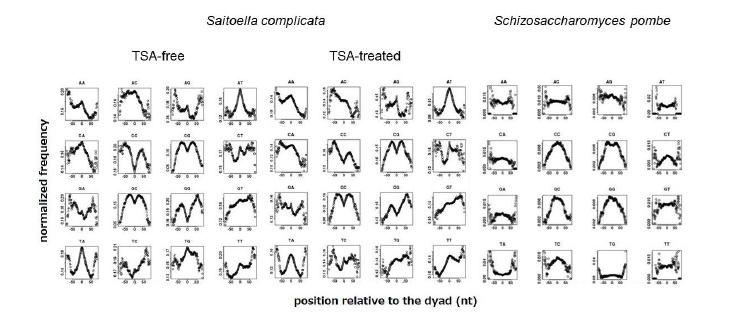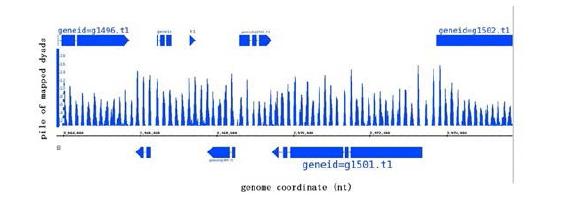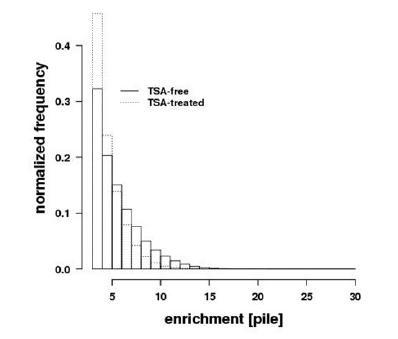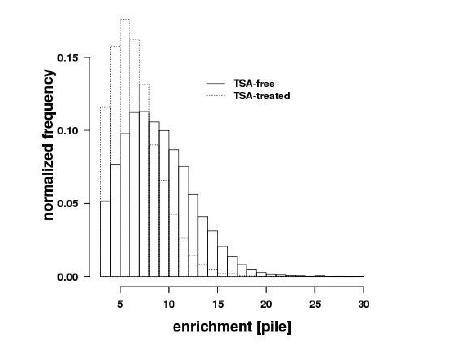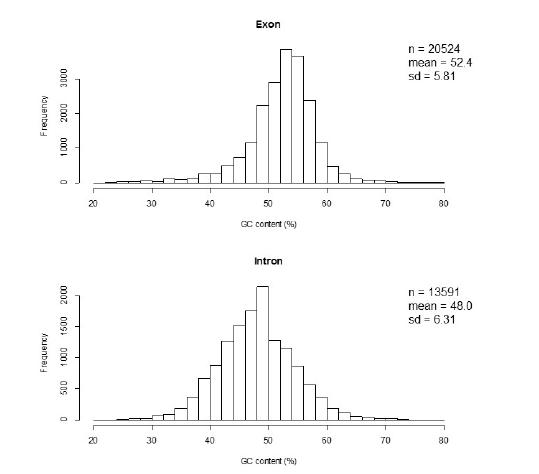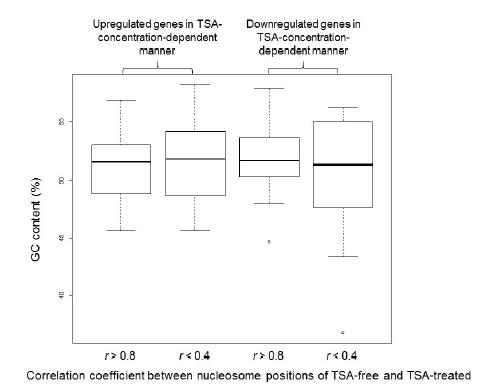1. Introduction
Eukaryotic genomic DNA is packaged with histones to form chromatin [1], the most fundamental repeating unit of which is the nucleosome [2]. The nucleosome consists of an octamer of histones, around which the DNA is wrapped 1.65 times [2]. Generally, histones are post-translationally modified [3]. Histone acetylation and deacetylation play important roles in the regulation of transcription [4,5]. Trichostatin A (TSA) is a histone deacetylase inhibitor, which induces hyperacetylation of histones [6,7].
Transcription (gene expression) and nucleosome position were compared between TSA-free and TSA-treated Aspergillusfumigatus (a member of the subphylum Pezizomycotina) [8]. Although TSA induced elongation of the nucleosomal DNA, most of the nucleosome positions were conserved in the gene promoters even after treatment with TSA [8].
The subphylum Taphrinomycotina (“Archiascomycetes”) is the earliest ascomycetous lineage during ascomycetous evolution [9,10]. The anamorphic and saprobic budding yeast Saitoellacomplicata is a member of Taphrinomycotina, which shares some characteristics with both ascomycetous and basidiomycetous yeasts [11]. Interestingly, the S. complicata genome is highly similar to Pezizomycotina genomes [12]. Although the fission yeast Schizosaccharomycespombe also belongs to Taphrinomycotina, genomic characteristics are different between S. complicata and Sch. pombe[13]. In Sch. pombe, TSA alters the structural and functional imprint at the centromeres [14].
In this study, we investigate the effects of TSA on gene expression and nucleosome position in S. complicata and discuss the relationships between DNA sequence, gene expression, and nucleosome position.The genomic guanine-cytosine (GC) content of S. complicata (52.6%) is so different from that of Sch. pombe (36.1%). We elucidate whether the difference influences the nucleosome formation or not.
2. Methods
2.1. Saitoellacomplicata culturing
Saitoellacomplicata NBRC 10748 (= JCM 7358, = IAM 12963; type strain) was used in this study. The strain was cultivated in YM broth (yeast extract, 3 g/L; malt extract, 3 g/L; peptone, 5g/L; dextrose, 10 g/L) at 25°C for 24 hours. S. complicata was cultured in the absence or the presence of TSA (1 μg/mL, 2 μg/mL, and 3 μg/mL).
2.2. Nucleosome mapping
S. complicatacultures grown in the presence of 0 μg/mL and 3 μg/mL TSA were used in the nucleosome mapping analysis. Equal volumes (22.5 mL) of S. complicata culture and 2% formaldehyde were mixed and incubated for 10 min followed by the addition of 5 mL of 1.25 M glycine. After S. complicata cells were collected and washed with 50 mM Tris-EDTA buffer (pH 8), the cells were suspended in zymolyase buffer (1 M sorbitol, 10 mM DTT, 50 mM Tris-HCl, pH 8.0). Zymolyase(Seikagaku corporation, Japan) (50 U) was added to the cell suspension and the solution was incubated at 37 °C for 1 h. The cells were collected by centrifugation and suspended in 2.5 mL of zymolyase buffer and MNase(Takara, Japan) (5 U) was added. The digestion reaction was incubated at 37 °C for 30 min and was stopped by adding sodium dodecylsulphate to a final concentration of 1% and ethylene diaminetetraacetic acid to a final concentration of 10 mM. Proteinase K solution (5 μg) was added to the solution and the mixture was incubated at 56 °C for 1 h. The solution was phenol/chloroform-extracted, ethanol-precipitated, and treated with RNase (Nippon Gene, Japan). Nucleosomal DNA fragments were isolated by electrophoresis using a 2% agarose gel. The mononucleosomal DNA band was excised and purified using the QIAquick Gel Extraction Kit (Qiagen). Both ends of the DNA fragments were sequenced using the Illumina HiSeq2500.
2.3. Mapping of nucleosome-mapping sequences
The read pairs were aligned to the genomic contigs (paired end 101 nucleotides (nt) and 150 nt insert) were mapped to the S. complicata genome [15] by using TopHat[16] and dereplicated by SAMtools[17]. Only uniquely mapped read pairs were used for the analysis. The DDBJ Supercomputer System [18] was used for mapping the Illumina reads to the genome and for additional analysis.
2.4. Overall disruption of nucleosome positioning in TSA-treated sample
To observe the trend of enrichment peaks, we operationally defined the peak positions of nucleosome dyads (dyad peaks) by using a threshold parameterization (the maximum pile (3) was given at the peak and in each of the ten up- and downstream positions flanking the peak; in seven or more position pairs the pile-level decreases outward from the peak).
2.5. Mapping of RNA-seq sequences and computation of expression levels
The RNAs were extracted and purified using the RNeasy Mini Kit (Qiagen). Quality of the extracted RNAs was checked by using Agilent 2100 Bioanalyzer. The Illumina sequences of single reads (36 nt length) were mapped to the S. complicata genome by using TopHat and dereplicated by SAMtools. The expression level of each gene (FPKM: fragments mapped per kilobase of transcript per million of mapped fragments) in the three samples was computed by using cuffdiff (http://cole-trapnell-lab.github.io/cufflinks) based on the coordinates mapped by the RNA-seq datasets.
2.6. Selection of genes with TSA-concentration-dependent expression
Based on the RNA expression data, we defined upregulated TSA-concentration-dependent genes as genes for which the expression level was at least 1.25 times higher when grown in 2 μg/mL of TSA than when grown in 1 μg/mL of TSA, and at least 1.25 times higher when grown in 3 μg/mL of TSA than when grown in 2 μg/mL of TSA. In addition, we defined downregulated TSA-concentration-dependent genes as genes for which the expression level was at least 0.75 times lower when grown in 2 μg/mL of TSA than that of 1 μg/mL of TSA, and that was at least 0.75 times lower when grown in 3 μg/mL of TSA than that of 2 μg/mL of TSA.Statistical estimation was performed by using edgeR [19].
3. Results
3.1. Characteristics of S. complicata cultured in 3 μg/mL of TSA
We observed abnormal cell shape (inaccurate budding) of S. complicata when grown in 3 μg/mL of TSA (Figure 1). Nucleosome formation is associated with the nucleosomalDNA sequence [20,21]. The dinucleotide sequence distributions were similar between TSA-free and TSA-treated, which were different from that of Sch. pombe (Figure 2).
We obtained 38872421 and 42603041 dereplicated sequence pairs for TSA-free and TSA-treated samples, respectively. Based on the genome positions mapped by paired sequences, we identified the dyads (mid-points) of nucleosomes. After counting the numbers of times mapped by the dyads (pile) [20] at each base on the genome, we computed average depth of mapped dyads within ± 5 nts and used this average depth as the measure of nucleosome enrichment. A typical enrichment pattern of nucleosome dyads is shown in Figure 3.
We measured the overall level of nucleosome positioning by counting the number of highly positioned (piled) nucleosome dyads and compared it between the TSA-free and TSA-treated samples (Figure 4). The level of piles decreased significantly (Mann-Whitney U-test p< 2.2×10−16) in TSA-treated sample compared to TSA-free sample. We identified 26711 and 20704 dyad-peaks in the control and post-TSA samples, respectively. The disruption was more evident (Mann-Whitney U-test p< 2.2×10−16) when comparing the enrichment level of the dyad peaks as shown in Figure 5.
We obtained 68464078, 49183262, and 60631468 dereplicated sequences (pairs) for 1 μg/mL, 2 μg/mL and 3 μg/mL of TSA-treated samples, respectively.
The DNA sequences of the nucleosomal DNA fragments and cDNA fragments from transcribed RNA have been deposited in DDBJ under the accession number DRA003112 and DRA003113, respectively.
3.2. TSA-concentration-dependent up- and downregulated genes
The expression of 154 genes increased in a TSA-concentration-dependent manner (Table 1) while the expression of 131 genes decreased in a TSA-concentration-dependent manner (Table 2). For a total of 285 gene products, we searched for similar amino acid sequences to Sch. pombe proteins using BLASTP [22]. We found that 53 (34.4%) of the 154 TSA-concentration-dependent upregulated genes and 107 (81.7%) of the 131 downregulated genes have similar amino acid sequences to Sch. pombe proteins (Tables 1 and 2). Conserved genes between S. complicata and Sch. pombe were more commonly TSA-concentration-dependent downregulated genes. The gene ontology information about 53 of the 154 upregulated genes is shown in Supplementary Material 1, inferred from AmiGo version 1.8 (http://amigo1.geneontology.org/cgi-bin/amigo/go.cgi).
3.3. Conservation and variation of nucleosome position at promoter region
We compared the nucleosome position profiles within 500 nt upstream and downstream from a translational start (Supplementary Materials 2 and 3). We calculated the correlation coefficients of nucleosome position profiles within 300 nt upstream from a translational start of the samples grown in 0 μg/mL and 3 μg/mL of TSA (Tables 1 and 2). We found that 20 (13.0%) of the 154 TSA-concentration-dependent upregulated genes and 22 (16.8%) of the 131 downregulated genes had different profiles (Pearson product-moment correlation coefficient r< 0.4) between TSA-free and TSA-treated samples. Additionally, 59 (38.3%) of the 154 upregulated genes and 58 (44.3%) of the 131 downregulated genes had similar profiles (r> 0.8).
3.4. Guanine-cytosine (GC) content bias
We compared the GC content between the exons and introns in all the genes of S. complicata. The GC content in the exons (mean = 52.4%, SD = 5.81) was higher than that of the introns (mean = 48.0%, SD = 6.31) (Figure4), which is consistent with previous reports [23,24,25].
Next, we compared the GC content of the 300 nt upstream of a translational start for the 20 upregulated and 22 downregulated genes with different nucleosome profiles and the 59 upregulated and 58 downregulated genes with similar nucleosome profiles. The result is shown in Figure5. Based on the analysis of variance, there was no significant difference between the four samples.
4. Discussion
Enriched and depleted dinucleotides distributions around the midpoints of highly positioned nucleosome dyads were similar between TSA-free and TSA-treated samples (Figure 2), indicating that the relationship between histone proteins and DNA sequence is conserved. Interestingly, the distributions (especially, the dinucleotide sequences AT, CG, GC, and TA) are similar to those of the basidiomyceteMixiaosmundae[26]. On the other hand, dinucleotide sequence distributions are different between S. complicata and Sch. pombe, except for CG and GC (Figure 2). Thus, the differences depended not on the phylogenetic relationships but on the genomic GC contents (S. complicata, 52.6 % of guanine-cytosine; Sch. pombe, 36.1%; and M. osmundae, 55.5%).
Of the 53 TSA-concentration-dependent upregulated genes with amino acid sequences similar to a Sch. pombeprotein, we found the genes that were likely upregulated due to the addition of TSA (Supplementary Material 1). For example, the genes G7K_1405-t1, G7K_3794-t1, G7K_4487-t1, G7K_4488-t1, and G7K_4878-t1 encode transmembrane proteins that may play a role in TSA discharge. The genes G7K_1576-t1, G7K_2158-t2, G7K_3085-t1, G7K_3100-t1, G7K_3152-t1, G7K_3948-t1, G7K_4351-t1, G7K_4878-t1, and G7K_6152-t2 encode proteins related to cell cycle and replication and may play a role in cell division. The genes G7K_1912-t1, G7K_2003-t1, G7K_2534-t1, G7K_2954-t1, G7K_3743-t1, G7K_4481-t1, and G7K_5043-t1 encode proteins related to chromatin, telomere, and centromere maintenance and may play a role in repairing nucleosome structure and positioning (Supplementary Material 1).
In the filamentous ascomycetesA. fumigatus and Aspergillusnidulans, expression of the histone deacetylase coding gene rpdA is stimulated by TSA [8,27]. Schizosaccharomyces clr6 is similar gene to AspergillusrpdA. S. complicata has two similar genes (G7K_4324-t1 and G7K_6383-t1) to clr6[13]. However, the expression of these genes was not stimulated with TSA. Interestingly, in S. complicata, the histone methyltransferase coding gene set2 homolog (G7K_4375-t1) expression increases in a TSA-concentration-dependent manner (Table 1), suggesting that the response of histone modification genes against TSA varies among ascomycetes.
Of the proteins that were encoded by the 107 TSA-concentration-dependent downregulated genes and that that had amino acid sequences similar to that of Sch. pombe, most were essential for cell maintenance. This suggests that the cell metabolic activity of S. complicata decreases in a TSA-concentration-dependent manner.
Genome-wide comparative studies reveal that the GC content and nucleosome density tend to be higher in exons than in introns [23,28,29,30,31,32]. Nucleosome positioning is related to DNA sequence:regions rich in guanine and cytosine favor nucleosomes compared to regions rich in adenine and thymine [33]. In this study, we found that the GC content in the exons was higher than that in the introns (Figure 6). However, GC content bias was not observed between the 300 nt upstream of the translational start of the TSA-concentration-dependent genes with conserved nucleosome positioning and the genes with different nucleosome positioning (Figure 7). This result suggests that TSA-induced nucleosome position change is likely not related to DNA sequence. Most gene promoters maintain the nucleosome positioning even after TSA treatment, which may be related to DNA sequence.
We expected gene expression to be related to the amount of nucleosomes in a gene’s promoter such that an increase of nucleosomes inhibits gene expression and a decrease activates expression. Among the 285 TSA-concentration-dependent genes, we found only nine candidate genes that fit this model (G7K_2954-t1, G7K_3456-t1, G7K_5145-t1, G7K_6368-t1, G7K_2158-t2, and G7K_4351-t1 of the 154 upregulated genes; G7K_2101-t1 and G7K6868-t1 of the 131 downregulated genes, Supplementary Materials 2 and 3). Therefore, in general, the amount and position of nucleosomes is maintained after TSA treatment.
5. Conclusion
In this study, we showed the nucleosome positioning robustness in the archiascomycetous yeast Saitoellacomplicata. Most gene promoters maintained their nucleosome positioning even after TSA treatment. Enriched and depleteddinucleotides distribution of S. complicata around the midpoints of highly positioned nucleosome dyads was not similar to that of the phylogenetically close yeast Schizosaccharomycespombe but similar to the basidiomyceteMixiaosmundae, which has similar genomic GC content to that of S. complicata.
Acknowledgment
This work was supported by JSPS KAKENHI grant no. 25440188 and 221S0002.
Conflict of Interest
The authors declare that there is no conflict of interest regarding the publication of this paper.
Table 1. Upregulated genes of S. complicata in TSA-concentration-dependent manner
*Significantly (p< 0.05) differentially expressed genes between growths in 1 μg/mL and 2 μg/mL of TSA.
#Significantly (p< 0.05)differentially expressed genes between growths in 2 μg/mL and 3 μg/mL of TSA. |
|
Locus tag (Protein ID)
|
Similar protein in Schizosaccharomycespombe
|
E-value
|
Expression level in absence of TSA [13]
|
Expression level at 1 μg/mL TSA
|
Expression level at 2 μg/mL TSA
|
Expression level at 3 μg/mL TSA
|
Correlation coefficient of nucleosome position profiles between TSA-free and TSA-treated
|
|
G7K_0004-t1
|
no hit
|
|
6.7
|
22.7
|
29.6
|
37.2
|
0.93
|
|
G7K_0068-t1*#
|
gi_19114122_ref_NP_593210.1_DNA_endonuclease_III
|
0.056
|
51.3
|
134.3
|
256.8
|
338.2
|
0.86
|
|
G7K_0387-t2
|
no hit
|
|
10.8
|
25
|
39.2
|
53.6
|
0.87
|
|
G7K_0436-t1*
|
no hit
|
|
56.2
|
14.3
|
55
|
77.9
|
0.81
|
|
G7K_0451-t1
|
no hit
|
|
30.2
|
14
|
28.6
|
36
|
0.89
|
|
G7K_0476-t1*#
|
no hit
|
|
90.7
|
183
|
328.4
|
450.6
|
0.71
|
|
G7K_0489-t1
|
no hit
|
|
40.5
|
21.6
|
33.5
|
45.2
|
0.35
|
|
G7K_0499-t1*#
|
gi_429242433_ref_XP_004001772.1_histone-fold_domain-containing_protein
|
6×10-12
|
460.8
|
299.3
|
540
|
751.4
|
0.11
|
|
G7K_0500-t1*
|
no hit
|
|
51.2
|
36.2
|
83.8
|
106
|
0.81
|
|
G7K_0501-t1*#
|
no hit
|
|
12.5
|
67.2
|
199.4
|
276.2
|
0.95
|
|
G7K_0518-t2
|
gi_429242230_ref_NP_593530.2_succinate_dehydrogenase_iron-sulfur_subunit_protein
|
2×10-128
|
1.7
|
9.8
|
15
|
24.6
|
0.91
|
|
G7K_0720-t1*#
|
no hit
|
|
296.1
|
44.3
|
78.8
|
110.9
|
0.8
|
|
G7K_0856-t1
|
no hit
|
|
2.2
|
2.1
|
3.1
|
5.9
|
0.35
|
|
G7K_0936-t1
|
gi_19115704_ref_NP_594792.1_COP9_signalosome_complex_subunit_12_(predicted)
|
1×10-84
|
68.5
|
2.2
|
2.9
|
4.4
|
0.79
|
|
G7K_0948-t1*
|
no hit
|
|
5.9
|
25.6
|
51.8
|
66.6
|
0.71
|
|
G7K_0986-t1
|
gi_295442985_ref_NP_593794.2_conserved_fungal_protein
|
4×10-30
|
8.6
|
13.3
|
25.9
|
32.4
|
0.2
|
|
G7K_1025-t1
|
no hit
|
|
2.4
|
3.2
|
4.4
|
5.8
|
0.48
|
|
G7K_1096-t1
|
no hit
|
|
1.5
|
6
|
15.8
|
20.3
|
0.11
|
|
G7K_1111-t1
|
no hit
|
|
0.7
|
89
|
114.7
|
144.8
|
0.73
|
|
G7K_1196-t1
|
no hit
|
|
25.1
|
16.3
|
20.9
|
31.5
|
0.78
|
|
G7K_1237-t1*#
|
no hit
|
|
229.7
|
128.9
|
209.8
|
282
|
0.98
|
|
G7K_1324-t2
|
gi_19114225_ref_NP_593313.1_carboxylic_ester_hydrolase_activity_(predicted)
|
0.074
|
16.5
|
3.7
|
5.5
|
8.5
|
0.95
|
|
G7K_1389-t1
|
gi_19113165_ref_NP_596373.1_U6_snRNP-associated_protein_Lsm5_(predicted)
|
7×10-29
|
3.7
|
11.4
|
19.1
|
28.1
|
0.81
|
|
G7K_1405-t1
|
gi_19113217_ref_NP_596425.1_hexose_transporter_Ght2
|
1×10-31
|
57.4
|
15.8
|
23.7
|
29.7
|
0.78
|
|
G7K_1454-t1
|
gi_19114259_ref_NP_593347.1_retrotransposable_element
|
6×10-79
|
1.8
|
0.3
|
1.1
|
1.3
|
0.88
|
|
G7K_1489-t1
|
no hit
|
|
36.8
|
17.1
|
21.6
|
28
|
0.78
|
|
G7K_1517-t2#
|
gi_19114517_ref_NP_593605.1_transcription_factor_(predicted)
|
1×10-21
|
48.3
|
0.3
|
0.4
|
18.6
|
0.66
|
|
G7K_1553-t1#
|
no hit
|
|
88.5
|
218.7
|
318.7
|
400
|
0.64
|
|
G7K_1576-t1
|
gi_19113817_ref_NP_592905.1_glycerate_kinase_(predicted)
|
4×10-56
|
59.2
|
18.5
|
29.3
|
36.8
|
0.96
|
|
G7K_1611-t1
|
no hit
|
|
1.6
|
0.2
|
0.3
|
0.7
|
0.94
|
|
G7K_1759-t1*
|
no hit
|
|
6.1
|
16.9
|
35.8
|
49.4
|
0.82
|
|
G7K_1847-t1#
|
gi_19111930_ref_NP_595138.1_oxysterol_binding_protein_(predicted)
|
2×10-116
|
1.9
|
11.7
|
17.8
|
37.7
|
0.17
|
|
G7K_1862-t1*#
|
no hit
|
|
99.5
|
47.8
|
90.2
|
122.8
|
0.68
|
|
G7K_1912-t1
|
gi_19114445_ref_NP_593533.1_conserved_eukaryotic_protein
|
3×10-24
|
13.4
|
17.4
|
30.3
|
38.5
|
0.9
|
|
G7K_1923-t1
|
no hit
|
|
92.9
|
16.6
|
25.2
|
31.5
|
0.6
|
|
G7K_1949-t1
|
no hit
|
|
2.4
|
3.3
|
7.2
|
9.2
|
0.62
|
|
G7K_1950-t1
|
no hit
|
|
1.3
|
0.4
|
0.7
|
1.5
|
0.79
|
|
G7K_1985-t1
|
gi_19112082_ref_NP_595290.1_ORMDL_family_protein_(predicted)
|
0.027
|
13.9
|
65.2
|
88
|
115.6
|
0.85
|
|
G7K_1992-t1
|
no hit
|
|
3.0
|
5.3
|
9.6
|
12.8
|
0.49
|
|
G7K_2003-t1
|
gi_19112851_ref_NP_596059.1_meiotic_cohesin_complex_subunit_Rec8
|
2×10-47
|
23.6
|
48
|
62.5
|
82.7
|
0.84
|
|
G7K_2031-t1*
|
gi_19114220_ref_NP_593308.1_cyclophilin_family_peptidyl-prolyl_cis-trans_isomerase_Cyp1
|
5×10-78
|
282.8
|
39.3
|
55.4
|
74.2
|
0.76
|
|
G7K_2060-t1
|
gi_19111966_ref_NP_595174.1_horsetail_movement_protein_Hrs1/Mcp6
|
0.048
|
9.5
|
19.3
|
36.1
|
46.4
|
0.65
|
|
G7K_2098-t1
|
gi_19115152_ref_NP_594240.1_WD_repeat_protein_Vps8_(predicted)
|
0.027
|
20.6
|
53.9
|
80.3
|
104.8
|
0.78
|
|
G7K_2107-t1#
|
no hit
|
|
17.1
|
100.7
|
148.8
|
206
|
0.81
|
|
G7K_2120-t2
|
gi_19114162_ref_NP_593250.1_CTNS_domain_protein_(SMART)
|
5×10-40
|
83.8
|
12.8
|
17.3
|
21.9
|
0.95
|
|
G7K_2128-t1
|
gi_19113493_ref_NP_596701.1_hexaprenyldihydroxybenzoate_methyltransferase_(predicted)
|
8×10-28
|
26.3
|
16
|
25.7
|
32.4
|
0.44
|
|
G7K_2158-t2#
|
gi_19113399_ref_NP_596607.1_DNA_replication_factor_C_complex_subunit_Rfc1
|
0
|
38.7
|
2.8
|
4.1
|
15.4
|
0.35
|
|
G7K_2199-t1*#
|
gi_162312510_ref_XP_001713094.1_dual_specificity_phosphatase_Stp1
|
3×10-58
|
64.0
|
306.6
|
732
|
957.9
|
0.63
|
|
G7K_2200-t1*#
|
no hit
|
|
6.1
|
448.7
|
849.3
|
1116.9
|
0.63
|
|
G7K_2201-t1#
|
no hit
|
|
28.4
|
539.3
|
772.3
|
966.1
|
0.61
|
|
G7K_2230-t1
|
no hit
|
|
6.1
|
4.7
|
9.6
|
15.1
|
0.85
|
|
G7K_2285-t1
|
no hit
|
|
10.1
|
9.1
|
18
|
23.1
|
0.65
|
|
G7K_2286-t1
|
no hit
|
|
16.1
|
13.1
|
25.1
|
33.2
|
0.32
|
|
G7K_2288-t1*
|
no hit
|
|
19.0
|
18.2
|
37.7
|
47.5
|
0.83
|
|
G7K_2324-t1
|
no hit
|
|
71.8
|
39.4
|
53.2
|
72.9
|
0.89
|
|
G7K_2534-t1
|
gi_19114992_ref_NP_594080.1_chromatin_modification-related_protein
|
1×10-16
|
86.5
|
30.1
|
45.7
|
57.7
|
0.92
|
|
G7K_2554-t1
|
no hit
|
|
4.2
|
8
|
16.3
|
21.6
|
0.76
|
|
G7K_2761-t1
|
no hit
|
|
0.0
|
0
|
0.1
|
6.4
|
0.58
|
|
G7K_2768-t1
|
no hit
|
|
75.7
|
12.2
|
17.5
|
25.5
|
-0.09
|
|
G7K_2894-t1
|
no hit
|
|
1.8
|
23.9
|
40.4
|
52.3
|
0.84
|
|
G7K_2896-t1
|
no hit
|
|
21.6
|
11.4
|
24.5
|
31.8
|
0.78
|
|
G7K_2953-t1*#
|
gi_429239757_ref_XP_004001700.1_DUF1242_family_protein,_secretory_pathway_component_Ksh1_(predicted)
|
2×10-21
|
285.9
|
201.2
|
349.5
|
445.6
|
0.81
|
|
G7K_2954-t1
|
gi_19115773_ref_NP_594861.1_ATP-dependent_DNA_helicase_Snf21
|
0.051
|
30.5
|
63.9
|
86.3
|
108.2
|
0.86
|
|
G7K_3085-t1
|
gi_19113352_ref_NP_596560.1_ATP-dependent_RNA_helicase_Slh1_(predicted)
|
6×10-94
|
19.7
|
14
|
19.5
|
24.7
|
0.91
|
|
G7K_3100-t1
|
gi_19113146_ref_NP_596354.1_DNA_polymerase_epsilon_catalytic_subunit_Pol2
|
0.088
|
11.6
|
9
|
16.8
|
22
|
0.5
|
|
G7K_3101-t1
|
no hit
|
|
3.3
|
13
|
21.3
|
31.5
|
0.56
|
|
G7K_3126-t1
|
no hit
|
|
82.2
|
21.1
|
30
|
37.9
|
0.38
|
|
G7K_3141-t1
|
no hit
|
|
71.8
|
24.2
|
31.8
|
41.9
|
0.85
|
|
G7K_3152-t1
|
gi_63054647_ref_NP_594707.2_PPPDE_peptidase_family_(predicted)
|
7×10-25
|
20.4
|
10.2
|
16.3
|
21
|
0.69
|
|
G7K_3172-t1
|
no hit
|
|
5.3
|
11.8
|
20.8
|
26.7
|
0.29
|
|
G7K_3369-t1
|
no hit
|
|
138.3
|
17.4
|
25.7
|
38.3
|
0.87
|
|
G7K_3412-t1
|
no hit
|
|
11.4
|
19.9
|
34.2
|
44.4
|
0.65
|
|
G7K_3434-t1
|
gi_429240854_ref_NP_596337.3_DUF55_family_protein
|
1×10-48
|
82.2
|
31.8
|
41.9
|
57.3
|
0.54
|
|
G7K_3456-t1
|
gi_19114335_ref_NP_593423.1_anaphase-promoting_complex_subunit_Apc11
|
7×10-37
|
65.7
|
43.2
|
57.8
|
73.8
|
0.21
|
|
G7K_3633-t1
|
no hit
|
|
10.4
|
17.3
|
33
|
42.8
|
0.75
|
|
G7K_3743-t1
|
gi_19075338_ref_NP_587838.1_nucleosome_assembly_protein_Nap1
|
0.095
|
43.1
|
26.9
|
39.2
|
52.8
|
0.95
|
|
G7K_3755-t1
|
no hit
|
|
4.6
|
3.2
|
4.2
|
5.3
|
0.82
|
|
G7K_3794-t1
|
gi_19114460_ref_NP_593548.1_membrane_transporter_(predicted)
|
1×10-52
|
78.9
|
19.1
|
29.7
|
38.1
|
0.94
|
|
G7K_3802-t1
|
no hit
|
|
8.2
|
20.5
|
26.9
|
33.9
|
0.76
|
|
G7K_3825-t1
|
no hit
|
|
61.8
|
19.4
|
26.8
|
33.9
|
0.8
|
|
G7K_3854-t1
|
no hit
|
|
7.1
|
25.3
|
37.7
|
51.8
|
0.63
|
|
G7K_3935-t1
|
no hit
|
|
29.3
|
27
|
39.9
|
53.7
|
0.94
|
|
G7K_3948-t1
|
gi_19114683_ref_NP_593771.1_conserved_fungal_protein
|
2×10-42
|
1.2
|
1.3
|
1.8
|
2.4
|
0.81
|
|
G7K_3958-t1
|
no hit
|
|
4.5
|
15.9
|
21
|
33.4
|
0.34
|
|
G7K_3981-t1
|
no hit
|
|
11.5
|
4.9
|
9.7
|
12.5
|
0.93
|
|
G7K_4023-t1
|
no hit
|
|
4.9
|
14.3
|
18
|
22.7
|
0.53
|
|
G7K_4104-t1
|
no hit
|
|
2.6
|
2.5
|
7.5
|
11.7
|
0.71
|
|
G7K_4107-t1
|
gi_19075830_ref_NP_588330.1_NADPH_quinone_oxidoreductase/ARE-binding_protein_(predicted)
|
6×10-30
|
48.0
|
19.1
|
26.2
|
33.4
|
0.84
|
|
G7K_4228-t1
|
no hit
|
|
2.4
|
14.5
|
27.3
|
34.3
|
0.47
|
|
G7K_4279-t1
|
no hit
|
|
17.3
|
14.5
|
27.7
|
39
|
-0.04
|
|
G7K_4337-t1
|
no hit
|
|
12.8
|
8.8
|
16.5
|
21.6
|
0.57
|
|
G7K_4351-t1
|
gi_19075465_ref_NP_587965.1_sequence_orphan
|
0.04
|
53.1
|
62.7
|
79.1
|
100.5
|
0.74
|
|
G7K_4373-t1*#
|
gi_19115171_ref_NP_594259.1_cullin_1
|
0.061
|
92.2
|
231.6
|
493.6
|
624.5
|
0.79
|
|
G7K_4375-t1
|
gi_19115892_ref_NP_594980.1_histone_lysine_methyltransferase_Set2
|
5×10-30
|
8.3
|
13.7
|
19.9
|
25
|
0.87
|
|
G7K_4481-t1
|
gi_19113570_ref_NP_596778.1_sister_chromatid_cohesion_protein/DNA_polymerase_eta_Eso1
|
7×10-112
|
29.0
|
16.2
|
21.5
|
27.2
|
0.93
|
|
G7K_4487-t1
|
gi_19114232_ref_NP_593320.1_MFS_myo-inositol_transporter
|
2×10-35
|
50.3
|
13.6
|
18.1
|
24.5
|
0.69
|
|
G7K_4488-t1
|
gi_19113098_ref_NP_596306.1_membrane_transporter_(predicted)
|
3×10-4
|
12.3
|
14.5
|
21.9
|
27.6
|
0.76
|
|
G7K_4531-t1
|
gi_19114945_ref_NP_594033.1_vacuolar_carboxypeptidase_(predicted)
|
1×10-108
|
10.7
|
11.5
|
18.9
|
24.3
|
0.65
|
|
G7K_4562-t1*#
|
no hit
|
|
20.1
|
115.9
|
206.7
|
263
|
0.51
|
|
G7K_4621-t1
|
no hit
|
|
90.0
|
50.2
|
73.5
|
96.8
|
0.43
|
|
G7K_4626-t1*
|
no hit
|
|
3.0
|
9.4
|
21.6
|
33.7
|
0.88
|
|
G7K_4723-t1#
|
no hit
|
|
200.4
|
216.3
|
300.9
|
423.3
|
0.55
|
|
G7K_4758-t2
|
no hit
|
|
155.8
|
21.7
|
27.8
|
38.5
|
0.83
|
|
G7K_4872-t1#
|
no hit
|
|
1.4
|
30.4
|
51.3
|
80.1
|
0.8
|
|
G7K_4878-t1
|
gi_19114272_ref_NP_593360.1_acetate_transmembrane_transporter_(predicted)
|
1×10-19
|
129.0
|
11.2
|
14.2
|
18.8
|
0.89
|
|
G7K_4889-t1*
|
no hit
|
|
13.2
|
40.7
|
93.8
|
117.6
|
0.54
|
|
G7K_4910-t1
|
no hit
|
|
17.2
|
24.2
|
36.1
|
45.7
|
0.88
|
|
G7K_5043-t1
|
gi_19113028_ref_NP_596236.1_cryptic_loci_regulator_Clr1
|
0.037
|
3.6
|
13.9
|
19.1
|
24.3
|
0.82
|
|
G7K_5072-t1*#
|
no hit
|
|
6.9
|
183.9
|
351.3
|
477.6
|
0.54
|
|
G7K_5145-t1
|
no hit
|
|
5.5
|
5.5
|
9.8
|
12.7
|
0.52
|
|
G7K_5191-t1
|
no hit
|
|
5.7
|
10.6
|
22.9
|
30.7
|
0.59
|
|
G7K_5192-t1
|
no hit
|
|
0.0
|
14.4
|
23.4
|
29.5
|
0.92
|
|
G7K_5194-t1
|
no hit
|
|
1234.1
|
41.8
|
57.8
|
73
|
0.94
|
|
G7K_5234-t1
|
no hit
|
|
7.5
|
9.6
|
19
|
24.2
|
-0.06
|
|
G7K_5242-t1
|
no hit
|
|
63.8
|
12.8
|
18
|
22.6
|
0.76
|
|
G7K_5356-t2
|
no hit
|
|
57.4
|
11.6
|
17.2
|
21.6
|
0.75
|
|
G7K_5404-t1
|
no hit
|
|
5.5
|
5.6
|
10.4
|
14.7
|
0.58
|
|
G7K_5504-t1
|
gi_19113988_ref_NP_593076.1_S-methyl-5-thioadenosine_phosphorylase_(predicted)
|
0.022
|
1.8
|
1.8
|
3.5
|
5.1
|
0.59
|
|
G7K_5505-t1
|
no hit
|
|
0.8
|
2.1
|
2.9
|
3.8
|
0.71
|
|
G7K_5583-t1
|
no hit
|
|
15.6
|
11.4
|
18.6
|
23.9
|
0.29
|
|
G7K_5604-t1
|
no hit
|
|
14.6
|
14.5
|
19.2
|
25.4
|
0.77
|
|
G7K_5676-t1
|
no hit
|
|
12.2
|
11.1
|
17.1
|
23.4
|
-0.02
|
|
G7K_5680-t1
|
no hit
|
|
15.8
|
12.4
|
26.4
|
34.1
|
0.52
|
|
G7K_5760-t1
|
no hit
|
|
25.3
|
15.5
|
21.1
|
26.9
|
0.9
|
|
G7K_5784-t1
|
no hit
|
|
1.1
|
0.4
|
0.8
|
1.1
|
0.63
|
|
G7K_5886-t1
|
no hit
|
|
12.2
|
52.5
|
79.2
|
102
|
0.74
|
|
G7K_6048-t1
|
gi_19113866_ref_NP_592954.1_ribosome_biogenesis_protein_(predicted)
|
5×10-10
|
159.6
|
59.4
|
85.1
|
111
|
0.67
|
|
G7K_6074-t1
|
no hit
|
|
12.2
|
19.2
|
27.4
|
34.4
|
0.71
|
|
G7K_6151-t1
|
no hit
|
|
1.3
|
6.9
|
12.7
|
21.6
|
0.63
|
|
G7K_6152-t2*
|
gi_19115599_ref_NP_594687.1_histidine_kinase_Mak1
|
8×10-15
|
7.2
|
0
|
6.1
|
16.1
|
0.93
|
|
G7K_6188-t1
|
no hit
|
|
0.6
|
0.9
|
2.4
|
3.1
|
0.9
|
|
G7K_6280-t1*
|
no hit
|
|
5.9
|
50.3
|
95.2
|
124.2
|
0.77
|
|
G7K_6291-t1
|
no hit
|
|
5.2
|
13.5
|
19.1
|
24.3
|
0.57
|
|
G7K_6301-t2
|
gi_19115307_ref_NP_594395.1_sequence_orphan
|
1×10-10
|
26.6
|
0
|
0
|
0
|
0.54
|
|
G7K_6361-t1
|
gi_19075350_ref_NP_587850.1_60S_ribosomal_protein_L36
|
3×10-14
|
2335.0
|
1
|
1.9
|
3.3
|
0.37
|
|
G7K_6443-t1
|
no hit
|
|
16.9
|
20.9
|
34.5
|
46.2
|
0.82
|
|
G7K_6445-t1
|
gi_19114696_ref_NP_593784.1_nonsense-mediated_decay_protein_Upf2
|
0.04
|
9.2
|
13.8
|
19.9
|
28.9
|
0.95
|
|
G7K_6454-t1
|
gi_429239609_ref_NP_595180.2_branched_chain_amino_acid_aminotransferase_Eca39
|
4×10-105
|
148.9
|
21.7
|
29.6
|
38.5
|
0.57
|
|
G7K_6461-t1
|
no hit
|
|
9.4
|
20.5
|
30.7
|
40.6
|
0.85
|
|
G7K_6499-t1
|
no hit
|
|
2.2
|
2.7
|
5
|
6.3
|
0.55
|
|
G7K_6500-t1
|
gi_19114259_ref_NP_593347.1_retrotransposable_element
|
9×10-17
|
1.2
|
1.1
|
2.1
|
4.2
|
0.11
|
|
G7K_6510-t1
|
no hit
|
|
10.1
|
17.8
|
23.2
|
30.7
|
0.75
|
|
G7K_6529-t1
|
no hit
|
|
23.2
|
20
|
27.7
|
34.7
|
0.89
|
|
G7K_6553-t1*#
|
no hit
|
|
62.6
|
56.1
|
95.3
|
131.9
|
0.48
|
|
G7K_6600-t1
|
no hit
|
|
194.5
|
27.9
|
36.7
|
46.3
|
0.27
|
|
G7K_6735-t1
|
no hit
|
|
48.7
|
27.9
|
48.3
|
64.6
|
0.86
|
|
G7K_6744-t1
|
no hit
|
|
8.8
|
34.9
|
50
|
71
|
0.72
|
|
G7K_6763-t1
|
no hit
|
|
3.3
|
2.7
|
5.2
|
9.3
|
0.65
|
|
G7K_6768-t1
|
gi_19114326_ref_NP_593414.1_nucleoporin_Nup184
|
0.022
|
25.3
|
7.6
|
9.8
|
12.3
|
0.47
|
|
G7K_6770-t1
|
no hit
|
|
5.9
|
48.3
|
62
|
84.2
|
0.89
|
|
G7K_6829-t1
|
gi_19114998_ref_NP_594086.1_transcriptional_repressor_Sak1
|
3×10-68
|
30.5
|
7.1
|
9
|
12.7
|
0.88
|
|
G7K_6872-t1
|
no hit
|
|
6.3
|
7.9
|
10.1
|
13.1
|
NA
|
|
G7K_6887-t1
|
no hit
|
|
76.9
|
34
|
47.7
|
62.2
|
0.92
|
|
G7K_6914-t1
|
no hit
|
|
19.3
|
19
|
30.2
|
42.4
|
0.89
|
Table 2. Downregulated genes of S. complicatain TSA-concentration-dependent manner
*Significantly (p< 0.05) differentially expressed genes between growths in 1 μg/mL and 2 μg/mL of TSA.
#Significantly (p< 0.05) differentially expressed genes between growths in 2 μg/mL and 3 μg/mL of TSA. |
|
Locus tag (Protein ID)
|
Similar protein in Schizosaccharomycespombe
|
E-value
|
Expression level in absence of TSA [13]
|
Expression level at 1 μg/mL TSA
|
Expression level at 2 μg/mL TSA
|
Expression level at 3 μg/mL TSA
|
Correlation coefficient of nucleosome position profiles between TSA-free and TSA-treated
|
|
G7K_0147-t1*#
|
gi_19075316_ref_NP_587816.1_malate_dehydrogenase_(predicted)
|
3×10-114
|
576.9
|
204.3
|
132.8
|
94
|
0.34
|
|
G7K_0202-t1*#
|
gi_19114075_ref_NP_593163.1_superoxide_dismutase_Sod1
|
9×10-74
|
1713.3
|
2241.2
|
1114.7
|
780.8
|
0.14
|
|
G7K_0215-t1#
|
gi_19115831_ref_NP_594919.1_F1-ATPase_alpha_subunit
|
0
|
351.0
|
1288.4
|
957.9
|
670.4
|
0.94
|
|
G7K_0234-t1*#
|
gi_19113755_ref_NP_592843.1_MAP_kinase_Sty1
|
0
|
283.9
|
326
|
192
|
137.9
|
0.91
|
|
G7K_0252-t1*#
|
gi_162312257_ref_NP_596103.2_2-isopropylmalate_synthase_Leu3
|
0
|
98.1
|
256.6
|
149.9
|
109.3
|
0.51
|
|
G7K_0263-t1*#
|
gi_19114714_ref_NP_593802.1_mitochondrial_hydrogen/potassium_transport_system_protein_(predicted)
|
1×10-19
|
215.4
|
281
|
161.1
|
108.7
|
0.78
|
|
G7K_0549-t1#
|
gi_19075198_ref_NP_587698.1_ubiquinol-cytochrome-c_reductase_complex_core_protein_Qcr2_(predicted)
|
2×10-69
|
103.1
|
245.3
|
180.6
|
131
|
0.87
|
|
G7K_0595-t1*#
|
gi_429242423_ref_NP_593718.2_citrate_synthase_Cit1
|
0
|
602.7
|
1031.8
|
710.8
|
482.6
|
0.77
|
|
G7K_0632-t1*#
|
gi_19075303_ref_NP_587803.1_19S_proteasome_regulatory_subunit_Rpn8_(predicted)
|
1×10-142
|
181.0
|
294.6
|
186.8
|
132.4
|
0.77
|
|
G7K_0674-t1*#
|
gi_19113610_ref_NP_596818.1_tetra_spanning_protein_1,_Tts1
|
4×10-30
|
482.8
|
670
|
406.3
|
282.4
|
0.94
|
|
G7K_0679-t1#
|
gi_19075785_ref_NP_588285.1_translation_elongation_factor_eEF3
|
0
|
312.0
|
712.7
|
525.1
|
382.1
|
0.48
|
|
G7K_0762-t1*#
|
gi_19112660_ref_NP_595868.1_NADH-dependent_flavin_oxidoreductase_(predicted)
|
3×10-100
|
218.5
|
356.7
|
217.8
|
147.7
|
-0.05
|
|
G7K_0764-t1*#
|
gi_429239441_ref_NP_588570.2_cell_surface_glycoprotein_(predicted),_DUF1773_family_protein_4
|
0.017
|
868.7
|
483.9
|
265.2
|
166.6
|
0.85
|
|
G7K_0808-t1#
|
gi_19115677_ref_NP_594765.1_cell_wall_protein_Gas1,_1,3-beta-glucanosyltransferase_(predicted)
|
2×10-161
|
310.1
|
275.2
|
202.3
|
150.6
|
0.96
|
|
G7K_1000-t1*#
|
gi_19075182_ref_NP_587682.1_catalase
|
2×10-102
|
668.0
|
643.7
|
419.8
|
279.1
|
0.3
|
|
G7K_1215-t1*#
|
gi_19075725_ref_NP_588225.1_translation_release_factor_class_II_eRF3
|
0
|
177.9
|
181.4
|
110.8
|
80.1
|
0.86
|
|
G7K_1218-t1*#
|
gi_162312364_ref_XP_001713040.1_20S_proteasome_component_alpha_3_(predicted)
|
8×10-108
|
448.8
|
408.7
|
213.3
|
144.9
|
0.87
|
|
G7K_1248-t1*#
|
gi_19112638_ref_NP_595846.1_cytochrome_c1_Cyt1_(predicted)
|
7×10-127
|
8.1
|
344.7
|
234.7
|
161.2
|
0.04
|
|
G7K_1281-t1*#
|
gi_19113828_ref_NP_592916.1_20S_proteasome_component_beta_4_(predicted)
|
6×10-89
|
366.9
|
376.7
|
211.4
|
151.8
|
0.76
|
|
G7K_1323-t1#
|
gi_19075527_ref_NP_588027.1_IMP_cyclohydrolase/phosphoribosylaminoimidazolecarboxamideformyltransferase
|
0
|
187.3
|
234.3
|
164.6
|
116
|
0.94
|
|
G7K_1362-t1*#
|
gi_19075540_ref_NP_588040.1_20S_proteasome_component_alpha_7,_Pre10_(predicted)
|
3×10-60
|
326.0
|
572.1
|
337.2
|
238.9
|
0.64
|
|
G7K_1363-t1*#
|
no hit
|
|
335.9
|
631.3
|
325.9
|
233.5
|
0.61
|
|
G7K_1496-t1#
|
gi_19075670_ref_NP_588170.1_acyl-coA_desaturase_(predicted)
|
0
|
452.7
|
278.8
|
192.1
|
142.2
|
0.94
|
|
G7K_1561-t1*#
|
gi_19115284_ref_NP_594372.1_20S_proteasome_component_alpha_5,_Pup2_(predicted)
|
5×10-137
|
285.3
|
368.5
|
190.6
|
124.9
|
0.8
|
|
G7K_1595-t1*#
|
gi_19112272_ref_NP_595480.1_19S_proteasome_regulatory_subunit_Rpt2
|
0
|
166.0
|
389
|
248
|
186
|
0.87
|
|
G7K_1606-t1*
|
gi_19114341_ref_NP_593429.1_UBX_domain_protein_Ubx3,_Cdc48_cofactor
|
3×10-61
|
210.7
|
158.2
|
89.4
|
65.7
|
0.95
|
|
G7K_1630-t1#
|
gi_19113237_ref_NP_596445.1_mannose-6-phosphate_isomerase_(predicted)
|
4×10-91
|
137.7
|
95.8
|
60.2
|
36.8
|
0.94
|
|
G7K_1663-t1*#
|
gi_19114753_ref_NP_593841.1_phosphoric_monoester_hydrolase_(predicted)
|
6×10-58
|
513.2
|
294.3
|
181.5
|
130.5
|
0.92
|
|
G7K_1703-t1#
|
no hit
|
|
111.5
|
298.5
|
221.4
|
164.3
|
0.85
|
|
G7K_1750-t1#
|
gi_19114508_ref_NP_593596.1_sequence_orphan
|
0.076
|
640.9
|
429.5
|
298.7
|
188
|
0.83
|
|
G7K_1847-t2#
|
gi_19111930_ref_NP_595138.1_oxysterol_binding_protein_(predicted)
|
6×10-115
|
669.3
|
162
|
115.3
|
73.6
|
0.17
|
|
G7K_1885-t1*#
|
gi_19112945_ref_NP_596153.1_phosphoglucomutase_(predicted)
|
0
|
333.4
|
303.2
|
189.6
|
136.4
|
0.78
|
|
G7K_1886-t1#
|
gi_19112660_ref_NP_595868.1_NADH-dependent_flavin_oxidoreductase_(predicted)
|
1×10-150
|
124.0
|
195.4
|
140.5
|
102.9
|
0.48
|
|
G7K_1891-t1#
|
gi_19112484_ref_NP_595692.1_fructose-bisphosphate_aldolase_Fba1
|
3×10-176
|
422.8
|
805.9
|
590.3
|
404.8
|
0.89
|
|
G7K_1908-t1*#
|
gi_19113003_ref_NP_596211.1_NAD_dependent_epimerase/dehydratase_family_protein
|
3×10-13
|
261.6
|
235.8
|
158.7
|
118.2
|
0.82
|
|
G7K_1940-t1*
|
gi_19112174_ref_NP_595382.1_acetolactate_synthase_catalytic_subunit
|
0
|
195.1
|
143.2
|
84.7
|
62.7
|
0.74
|
|
G7K_2008-t1#
|
gi_295442792_ref_NP_588397.3_fumarate_hydratase_(predicted)
|
0
|
587.3
|
846.2
|
617.3
|
415.1
|
0.85
|
|
G7K_2064-t1*#
|
no hit
|
|
2067.0
|
408.5
|
229.3
|
167.9
|
0.53
|
|
G7K_2069-t1*#
|
gi_19114777_ref_NP_593865.1_hexokinase_2
|
2×10-123
|
269.4
|
441.1
|
271.9
|
181.6
|
0.97
|
|
G7K_2101-t1*#
|
gi_19114158_ref_NP_593246.1_ATP-citrate_synthase_subunit_2_(predicted)
|
0
|
367.8
|
293.2
|
151.9
|
101.8
|
0.56
|
|
G7K_2323-t1*#
|
gi_19112075_ref_NP_595283.1_ubiquitin_conjugating_enzyme_Ubc4
|
7×10-70
|
1514.7
|
479.5
|
294.8
|
204.1
|
0.83
|
|
G7K_2351-t1*#
|
gi_63054710_ref_NP_595282.2_19S_proteasome_regulatory_subunit_Rpn3
|
1×10-159
|
196.7
|
207.2
|
92.3
|
60.5
|
0.82
|
|
G7K_2360-t1#
|
gi_19113123_ref_NP_596331.1_dihydrolipoyllysine-residue_succinyltransferase
|
2×10-168
|
673.0
|
139.8
|
92.3
|
65.9
|
0.94
|
|
G7K_2374-t1*#
|
gi_19113114_ref_NP_596322.1_mitochondrial_Mam33_family_protein_(predicted)
|
1×10-28
|
378.7
|
660.1
|
404.3
|
273.6
|
0.81
|
|
G7K_2426-t1#
|
gi_19113109_ref_NP_596317.1_serine/threonine_protein_phosphatase_PP1
|
0
|
260.1
|
291.8
|
213.5
|
153.6
|
0.85
|
|
G7K_2476-t1*
|
no hit
|
|
144.8
|
88.8
|
53.2
|
36.9
|
0.9
|
|
G7K_2810-t1*#
|
gi_19115013_ref_NP_594101.1_20S_proteasome_component_alpha_6_subunit_Pre5_(predicted)
|
5×10-103
|
267.4
|
172.6
|
90.4
|
64.1
|
-0.07
|
|
G7K_2811-t1*#
|
no hit
|
|
2855.1
|
1196.1
|
690.2
|
497.1
|
-0.1
|
|
G7K_3019-t1#
|
gi_19075363_ref_NP_587863.1_translation_elongation_factor_2_(EF-2)_Eft2,B
|
0
|
627.0
|
1586.5
|
1160.9
|
814.6
|
0.91
|
|
G7K_3069-t1*#
|
no hit
|
|
264.5
|
196.5
|
116.4
|
87
|
0.63
|
|
G7K_3139-t1*#
|
gi_19075931_ref_NP_588431.1_BAX_inhibitor_family_protein_Bxi1
|
1×10-08
|
561.2
|
528.8
|
308.8
|
223.1
|
0.71
|
|
G7K_3223-t2*#
|
gi_19112979_ref_NP_596187.1_40S_ribosomal_protein_S23
|
1×10-73
|
206.7
|
474.8
|
294.2
|
201.5
|
0.7
|
|
G7K_3234-t1#
|
gi_19112083_ref_NP_595291.1_asparagine_synthetase
|
0
|
134.2
|
285.2
|
210.5
|
153.3
|
0.94
|
|
G7K_3235-t1*#
|
no hit
|
|
360.6
|
993.7
|
568.3
|
365.4
|
0.19
|
|
G7K_3283-t1*#
|
gi_19111957_ref_NP_595165.1_20S_proteasome_component_alpha_4_Pre6
|
1×10-122
|
146.4
|
305.2
|
168.4
|
117.2
|
0.86
|
|
G7K_3385-t1*#
|
gi_19114337_ref_NP_593425.1_V-type_ATPase_V1_domain,_subunit_A
|
0
|
397.8
|
149.1
|
79.1
|
43.2
|
0.91
|
|
G7K_3396-t2
|
gi_19115251_ref_NP_594339.1_glucan_1,4-alpha-glucosidase_(predicted)
|
0
|
50.5
|
7.7
|
4.7
|
2.9
|
0.57
|
|
G7K_3517-t1*#
|
gi_19113523_ref_NP_596731.1_S-adenosylmethionine_synthetase
|
0
|
170.0
|
1240.7
|
659.9
|
432.3
|
0.83
|
|
G7K_3576-t1*#
|
gi_19112963_ref_NP_596171.1_19S_proteasome_regulatory_subunit_Mts4
|
0
|
152.5
|
254.5
|
139.2
|
95.1
|
0.76
|
|
G7K_3638-t1*#
|
no hit
|
|
1819.6
|
572.8
|
381.5
|
271.8
|
0.66
|
|
G7K_3645-t1*#
|
no hit
|
|
218.7
|
891.1
|
586.7
|
392.2
|
0.77
|
|
G7K_3680-t1*#
|
gi_19114264_ref_NP_593352.1_homocysteine_methyltransferase_Met26
|
4×10-10
|
61.8
|
249.8
|
127.1
|
82.1
|
0.03
|
|
G7K_3703-t1*#
|
no hit
|
|
369.9
|
196.8
|
123.2
|
83.9
|
0.86
|
|
G7K_3714-t1*
|
gi_295442859_ref_NP_595976.2_topoisomerase_II-associated_deadenylation-dependent_mRNA-decapping_factor_(predicted)
|
1×10-123
|
80.0
|
90.3
|
54.2
|
40
|
0.54
|
|
G7K_3737-t1*#
|
gi_19114527_ref_NP_593615.1_ubiquitinated_histone-like_protein_Uhp1
|
4×10-80
|
257.3
|
662.9
|
391.6
|
292
|
0.82
|
|
G7K_3769-t1
|
gi_429238683_ref_NP_587854.2_kinetochore_protein_Mis18
|
8×10-24
|
114.2
|
89.5
|
61.2
|
42.5
|
0.2
|
|
G7K_3850-t1
|
gi_19075178_ref_NP_587678.1_ThiJ_domain_protein
|
2×10-11
|
1003.1
|
120
|
80.3
|
59.2
|
0.87
|
|
G7K_3853-t1#
|
gi_19113860_ref_NP_592948.1_hexokinase_1
|
1×10-171
|
50.8
|
121.1
|
90.3
|
48.6
|
0.74
|
|
G7K_3870-t1*#
|
gi_19115456_ref_NP_594544.1_20S_proteasome_component_beta_2_(predicted)
|
1×10-123
|
393.4
|
309.4
|
170.5
|
116.4
|
0.87
|
|
G7K_3892-t1*#
|
gi_19112166_ref_NP_595374.1_20S_proteasome_component_alpha_1_(predicted)
|
1×10-76
|
291.4
|
278
|
168.9
|
126.2
|
0.82
|
|
G7K_3929-t1*#
|
gi_19112028_ref_NP_595236.1_glyceraldehyde_3-phosphate_dehydrogenase_Gpd3
|
1×10-177
|
336.0
|
2659.7
|
1856.3
|
1288.9
|
0.65
|
|
G7K_3952-t1*#
|
gi_19112883_ref_NP_596091.1_heat_shock_protein_Hsp16
|
5×10-7
|
767.7
|
419.2
|
220.8
|
156.5
|
0.71
|
|
G7K_3969-t1*#
|
gi_19114312_ref_NP_593400.1_glutamate-ammonia_ligase_Gln1
|
0
|
1245.3
|
882
|
619
|
442.4
|
0.76
|
|
G7K_3976-t1
|
gi_19112179_ref_NP_595387.1_ADP-ribose_diphosphatase,_NudF_subfamily_(predicted)
|
2×10-75
|
262.4
|
79.9
|
51.8
|
37.2
|
0.66
|
|
G7K_3978-t1#
|
gi_19115256_ref_NP_594344.1_3-hydroxyacyl-CoA_dehydrogenase_(predicted)
|
3×10-83
|
427.8
|
173
|
115.5
|
79.6
|
0.58
|
|
G7K_4017-t1#
|
no hit
|
|
717.8
|
1128.8
|
805.4
|
560.6
|
0.87
|
|
G7K_4024-t1*#
|
gi_429238993_ref_NP_588144.2_prohibitin_Phb2_(predicted)
|
3×10-139
|
971.2
|
626
|
360.8
|
242.3
|
0.61
|
|
G7K_4029-t1#
|
gi_19075641_ref_NP_588141.1_phosphoribosylaminoimidazole_carboxylase_Ade6
|
0
|
66.5
|
149.5
|
110.9
|
79.2
|
0.88
|
|
G7K_4074-t1#
|
no hit
|
|
2060.7
|
972.6
|
714.4
|
512.5
|
0.92
|
|
G7K_4151-t1*#
|
gi_63054529_ref_NP_593287.2_AAA_family_ATPase_Cdc48
|
0
|
269.5
|
310.5
|
169.4
|
122.6
|
0.93
|
|
G7K_4199-t1#
|
gi_19115300_ref_NP_594388.1_5-aminolevulinate_synthase_(predicted)
|
0
|
157.2
|
149.7
|
104.6
|
77.2
|
0.39
|
|
G7K_4282-t1*#
|
gi_19112456_ref_NP_595664.1_cyclophilin_family_peptidyl-prolyl_cis-trans_isomerase_Cyp2
|
1×10-99
|
1439.1
|
2241.3
|
1518.3
|
988.8
|
0.73
|
|
G7K_4306-t1*#
|
gi_19113838_ref_NP_592926.1_WD_repeat-containing_protein
|
0.032
|
400.9
|
397.4
|
266.6
|
188.6
|
0.72
|
|
G7K_4365-t1*#
|
gi_19075632_ref_NP_588132.1_UTP-glucose-1-phosphate_uridylyltransferase_(predicted)
|
8×10-36
|
547.8
|
723.8
|
414.9
|
269.1
|
0.73
|
|
G7K_4366-t1*#
|
no hit
|
|
638.8
|
951.5
|
579.5
|
416.4
|
0.9
|
|
G7K_4517-t1#
|
gi_19112201_ref_NP_595409.1_ubiquitin
|
2×10-101
|
508.6
|
648.5
|
469.7
|
335.5
|
-0.25
|
|
G7K_4556-t1*#
|
gi_19113238_ref_NP_596446.1_beta-glucosidase_Psu2_(predicted)
|
4×10-107
|
261.7
|
295.2
|
168.4
|
97.3
|
0.38
|
|
G7K_4642-t1*#
|
gi_19115123_ref_NP_594211.1_mitochondrial_2-oxoadipate_and_2-oxoglutarate_transporter_(predicted)
|
4×10-127
|
198.6
|
172
|
112.5
|
82.9
|
0.79
|
|
G7K_4647-t1*#
|
gi_19115142_ref_NP_594230.1_succinate-CoA_ligase_alpha_subunit_(predicted)
|
5×10-155
|
504.6
|
454.4
|
282.9
|
200.7
|
0.86
|
|
G7K_4662-t1*#
|
gi_19112410_ref_NP_595618.1_actin_Act1
|
0
|
824.1
|
1039.1
|
658
|
423.1
|
0.61
|
|
G7K_4696-t1*#
|
gi_19114023_ref_NP_593111.1_19S_proteasome_regulatory_subunit_Rpn6_(predicted)
|
1×10-155
|
174.6
|
275.8
|
165.2
|
117.1
|
0.85
|
|
G7K_4699-t1*#
|
gi_19112359_ref_NP_595567.1_histone_H3_h3.2
|
2×10-91
|
1774.9
|
1032.7
|
673.3
|
484.4
|
0.4
|
|
G7K_4745-t1
|
gi_19115641_ref_NP_594729.1_20S_proteasome_component_beta_6
|
3×10-31
|
336.3
|
91.3
|
59.3
|
43
|
0.29
|
|
G7K_4813-t1*#
|
gi_19114136_ref_NP_593224.1_methylenetetrahydrofolate_reductase_Met9
|
0
|
90.8
|
191
|
107
|
79.5
|
0.9
|
|
G7K_4847-t1#
|
gi_19114548_ref_NP_593636.1_inorganic_pyrophosphatase_(predicted)
|
5×10-155
|
586.6
|
1273.7
|
936.3
|
650.6
|
0.83
|
|
G7K_4869-t1*#
|
gi_19111913_ref_NP_595121.1_alcohol_dehydrogenase_(predicted)
|
5×10-104
|
114.9
|
306.5
|
135.6
|
81
|
0.75
|
|
G7K_4938-t1*#
|
gi_162312184_ref_NP_595526.2_transmembrane_receptor_Wsc1_(predicted)
|
2×10-15
|
658.3
|
423.1
|
283.1
|
204.6
|
0.91
|
|
G7K_4969-t1#
|
gi_19115804_ref_NP_594892.1_pyruvate_dehydrogenase_e1_component_alpha_subunit_Pda1_(predicted)
|
0
|
390.8
|
324
|
223.8
|
152
|
0.91
|
|
G7K_5057-t1*#
|
gi_162312305_ref_XP_001713148.1_ubiquitin_activating_enzyme_E1
|
0
|
298.9
|
214.3
|
114.6
|
84.1
|
0.86
|
|
G7K_5063-t1*#
|
no hit
|
|
1403.2
|
188.4
|
108.1
|
76.9
|
0.62
|
|
G7K_5162-t1
|
gi_19113624_ref_NP_596832.1_UDP-N-acetylglucosamine_diphosphorylase_Uap1/Qri1(predicted)
|
1×10-115
|
132.3
|
118.7
|
79.1
|
59
|
0.62
|
|
G7K_5321-t1*#
|
gi_19115722_ref_NP_594810.1_pyridoxamine_5'-phosphate_oxidase_(predicted)
|
4×10-52
|
504.7
|
228.8
|
149
|
107.7
|
0.46
|
|
G7K_5384-t1*
|
no hit
|
|
188.7
|
113.6
|
69.9
|
52.3
|
0.68
|
|
G7K_5501-t1#
|
no hit
|
|
1.8
|
99.8
|
71.6
|
49
|
0.71
|
|
G7K_5530-t1*#
|
gi_19111898_ref_NP_595106.1_tubulin_alpha_2
|
0
|
556.2
|
639.1
|
446.1
|
325.9
|
0.84
|
|
G7K_5545-t1*#
|
gi_68013174_ref_NP_001018848.1_thioredoxin_reductase_Trr1
|
7×10-166
|
44.8
|
171.9
|
95.2
|
65.7
|
0.91
|
|
G7K_5751-t1#
|
gi_19112381_ref_NP_595589.1_mitochondrial_glutathione_reductase_Pgr1
|
0
|
113.3
|
155.4
|
101.8
|
65.9
|
0.94
|
|
G7K_5848-t1
|
gi_19115217_ref_NP_594305.1_thymidylate_synthase_(predicted)
|
2×10-65
|
76.3
|
82.9
|
55.3
|
40.4
|
0.84
|
|
G7K_5853-t1#
|
no hit
|
|
300.8
|
194.5
|
140.3
|
101.5
|
0.36
|
|
G7K_5962-t1
|
no hit
|
|
28.3
|
59.9
|
44.9
|
33.2
|
0.37
|
|
G7K_5982-t1*#
|
gi_19075803_ref_NP_588303.1_translation_elongation_factor_EF-1_beta_subunit_(eEF1B)
|
2×10-72
|
287.4
|
1561.8
|
1016.6
|
729.1
|
0.93
|
|
G7K_6002-t1*#
|
no hit
|
|
288.3
|
240.2
|
123.8
|
76.8
|
0.3
|
|
G7K_6163-t1*#
|
gi_19114506_ref_NP_593594.1_19S_proteasome_regulatory_subunit_Rpn9
|
3×10-127
|
134.1
|
180.2
|
96.7
|
65.8
|
0.81
|
|
G7K_6170-t1#
|
gi_19114408_ref_NP_593496.1_dihydrolipoamide_dehydrogenase_Dld1
|
0
|
282.9
|
296.2
|
218.5
|
161
|
0.67
|
|
G7K_6181-t1*#
|
no hit
|
|
310.3
|
2072.9
|
1436.1
|
997.6
|
0.35
|
|
G7K_6190-t1*
|
gi_19111859_ref_NP_595067.1_isocitrate_lyase_(predicted)
|
3×10-107
|
862.5
|
79.9
|
37.2
|
27.2
|
0.58
|
|
G7K_6245-t1
|
gi_63054449_ref_NP_588301.2_Swr1_complex_bromodomain_subunit_Brf1
|
4×10-106
|
78.8
|
8.4
|
5.9
|
3.3
|
0.34
|
|
G7K_6360-t1#
|
gi_19113748_ref_NP_592836.1_cell_wall_protein_Asl1,_predicted_O-glucosyl_hydrolase
|
1×10-33
|
358.1
|
147.5
|
108.3
|
79.8
|
0.91
|
|
G7K_6363-t1*#
|
gi_19075485_ref_NP_587985.1_20S_proteasome_component_beta_3,_Pup3_(predicted)
|
1×10-106
|
219.7
|
428.3
|
212.5
|
152.7
|
0.81
|
|
G7K_6381-t1
|
gi_19112124_ref_NP_595332.1_cysteine_synthase
|
6×10-157
|
129.0
|
5.9
|
3.9
|
2.6
|
0.71
|
|
G7K_6516-t1*#
|
gi_19115488_ref_NP_594576.1_3-isopropylmalate_dehydratase_Leu2_(predicted)
|
0
|
188.8
|
104.7
|
64.5
|
41.4
|
0.46
|
|
G7K_6537-t1*#
|
no hit
|
|
2973.8
|
2751.4
|
1588.9
|
1109
|
0.71
|
|
G7K_6581-t1*#
|
gi_19113432_ref_NP_596640.1_dolichol-phosphate_mannosyltransferase_subunit_3
|
1×10-9
|
485.5
|
70.6
|
32
|
12.7
|
0.6
|
|
G7K_6602-t1*#
|
no hit
|
|
1031.0
|
347.2
|
222.7
|
165.8
|
0.85
|
|
G7K_6616-t1*
|
gi_429242792_ref_NP_594069.2_endocytosis_protein
|
0
|
95.5
|
137.2
|
87.6
|
65.2
|
0.67
|
|
G7K_6625-t1*#
|
gi_19114619_ref_NP_593707.1_acyl-coA-sterol_acyltransferase_Are1_(predicted)
|
8×10-121
|
84.0
|
227.8
|
134.6
|
100.2
|
0.68
|
|
G7K_6634-t1#
|
no hit
|
|
69.4
|
111.3
|
75.4
|
51.9
|
0.43
|
|
G7K_6654-t1#
|
gi_19113884_ref_NP_592972.1_saccharopine_dehydrogenase_Lys3
|
8×10-179
|
148.8
|
267.6
|
184.2
|
130.4
|
0.76
|
|
G7K_6783-t1*#
|
gi_19113064_ref_NP_596272.1_pyruvate_dehydrogenase_e1_component_beta_subunit_Pdb1
|
1×10-176
|
1018.6
|
371.4
|
235
|
151.5
|
0.79
|
|
G7K_6868-t1*#
|
no hit
|
|
119.7
|
2745.3
|
354.9
|
256.2
|
-0.23
|
|
G7K_6890-t2*#
|
gi_19075338_ref_NP_587838.1_nucleosome_assembly_protein_Nap1
|
4×10-129
|
256.2
|
240.9
|
139
|
90
|
0.94
|









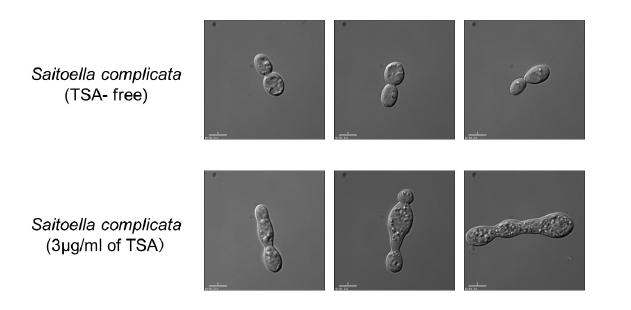
 DownLoad:
DownLoad: 